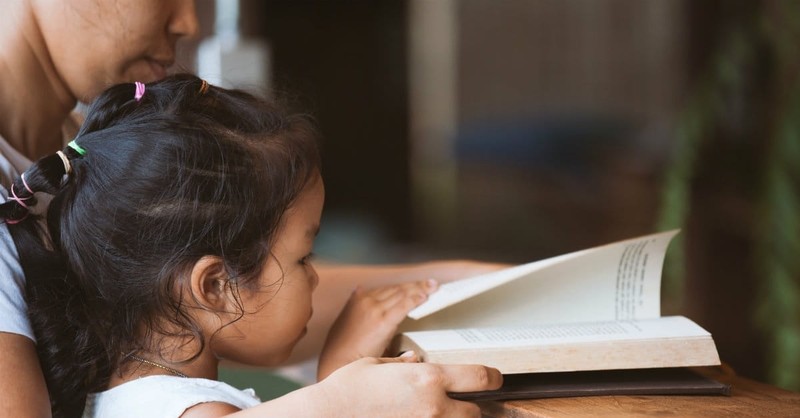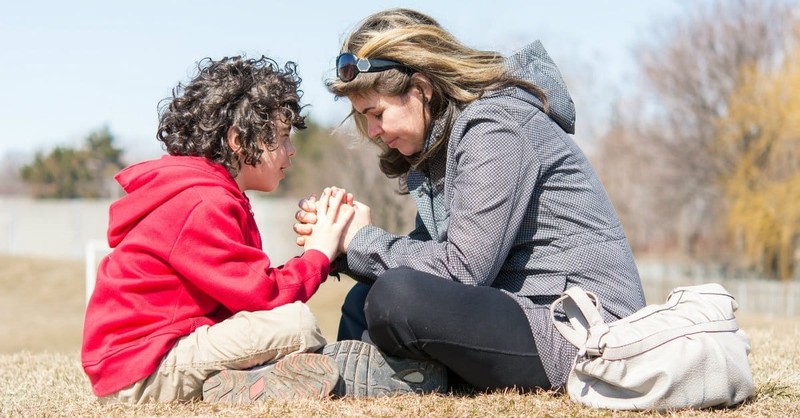
From the time my daughters were babies, I quizzed them on their understanding of the Bible. I held up the Bible and said, "What is this?" "The Bible. God's true word," they'd repeat on cue. But for children, Bible stories aren't much different from fantasy stories they read and play. A big boat housing animals for 40 days, a giant slayed at the hands of a boy, three men surviving a furnace, being swallowed by a giant fish, or feeding a tribe with only five loaves of bread and two fish all make for fantastical children's stories.
How do we, then, show our children that Bible stories aren't virtuous, Christian fables, but true past events that unfold Jesus' Gospel? I ask myself this question often as I read and teach my daughters the Bible. Here are a few ways I try to do it.
Photo Credit: Thinkstock

Relate Bible Stories Back to Your Children's Real Life Situations
My youngest daughter went to preschool for the first time this year. At first, she loved it. Then the novelty wore off and anxiety set in. She cried, screamed, and held onto me each morning when I dropped her off. Every day was a fight to get her there.
At church, she was learning about young David and how God gave him the courage to defeat the giant Goliath even though David was just a boy. I explained to my daughter that God will give her courage, too, as she faces her fear of going to preschool. I also explained to her the gift of the Holy Spirit that we receive when we give our lives to Jesus. Unlike the men and women of the Old Testament, we have Jesus with us all the time through the Holy Spirit who lives within us. Then, I prayed with her. I asked God to make His presence known to my daughter so that she can have courage, and I prayed for her salvation so that she can receive the gift of the Holy Spirit.
This may seem like a lot for a young child, and it may be; however, I'm planting seeds for her so that as she grows she understands that the Bible is not just a book of awesome stories. Instead, it is the living and active Word of God (Hebrews 4:12). My hope is that conversations such as these will train her to see the stories in the Bible as applicable to her everyday life. Then, as she faces problems, she'll go first to the Bible to look for answers.
Photo credit: ©Thinkstock

Talk about Jesus When Reading the Old Testament
It's important that children understand that the Bible isn't a book of individual, unrelated stories, but the individual stories weave together to tell one big story—the story of Jesus. The Old Testament is essential because it explains to us the character of God and the necessity for Jesus.
The Old Testament contains the most fantastical stories of any literature ever written—so much so that it's easy to assume that it's full of allegory. It's hard to imagine the events factually happened as they are written; however, when you study the Bible as a whole, believe the indescribable power of God and what He was trying to accomplish to show His people His character, and understand the final goal of sending a Savior to redeem humankind, you know the Old Testament stories are true. This is what we want to show our children.
We can relate Jesus back to every story in the Old Testament. The children's Bible that does this best is the Jesus Storybook Bible by Sally Lloyd-Jones. For example, when we're reading the story of Noah building the ark, we think there's no way a man could build a boat large enough to hold two of every kind of animal. We also think about how crazy he must have looked to build a boat in the desert where it never rained. But when we remember the holiness of God, how He can't be around sin but wanted to redeem a remnant of His people for His glory, and how He did that through starting over and eventually sending Jesus, we see the Gospel of Jesus.
The more familiar our children become with the Bible, the easier it will be for us to make the connection between each story and the Gospel for them.
Photo credit: ©Thinkstock

Be Honest about Real and Make-Believe, Fact and Fiction
When you walk into my girls' bedroom, you can become whatever character you wish. They have costumes for princesses to fairies to community helpers. Dressing up and pretending is one of their favorite ways to play. Research tells us the importance of children's imaginary play. It's where they enter a world all their own.
Because the Bible has some of the most far-fetched stories, children can assume they are the same as the imaginary stories they play. Like fairy tales and superhero missions, events in the Bible don't happen in children's reality, so they assume they're make-believe. The difference is that God of the universe is the one who willed the events in the Bible for a specific purpose in time, and nothing is impossible with Him. The events in the Bible are not fiction. They are fact.
In order to help my children not get confused about real and make-believe, fact and fiction, I am intentional about being honest with them. For example, when they see the Chick-fil-A cow I explain that it's really a costume. When they see a "real-life princess" I explain to them that it is a woman dressed up as a princess. My children even know the truth about Santa Claus.
This may seem extreme, and for some people it is, but it is important to me for them to differentiate between the seemingly fantastical events in the Bible created because God is full of majesty and capable of creating such events, and the fantastical images in our culture that are truly make-believe. My children still pretend that these characters are real. They sit on Santa's lap and have princess parties. But they know that they are pretending.
Photo credit: ©Thinkstock

Point Out Evidence of God's Presence in Nature
The Bible tells us in Romans 1:20 that we can know God's eternal power and divine nature from what He's created. I use this as an opportunity to teach my children the truth of God's Word.
Sometimes sitting at the table at dinner I'll say to my girls, "Look outside. Do you see the trees and grass? Do you know that they know God, their Creator? Do you know that the earth is moaning for Jesus' return just like we long for Him to come back?" (Romans 8:19-27). When there's a rainbow in the sky we talk about God's promise to never flood the earth again and His promise that Jesus will come back to earth one day to get us and take us to heaven.
When we go on walks around the neighborhood of our small town we see several old cemeteries. I use them as an opportunity to talk to my girls about people who died in the Old and New Testaments, about what happens when we die, and how one day, if they give their lives to Jesus, they will get to see heroes from the Bible in heaven.
God's creation tells His story of redemption. All we have to do is pay attention to it. Everyday occurrences in nature give us ample opportunities to teach our children the truth of the Bible and Jesus' Gospel.
Photo credit: Unsplash

Use Stories from the Bible While Praying
The other night my daughter had a fever. When I tucked her into bed I prayed over her and said, "Jesus, you know how you healed Peter's mother-in-law who was sick with a fever? Will you please heal my little girl in the same way?" (Matthew 8:14-15). Using the Bible to pray specifically with my girls helps them to make the connection between Jesus and themselves. They see that the Bible is true, living and active and that it is for them, wanting them to grow closer to God.
Sometimes the Bible seems daunting. It's difficult for us to read and understand, so we're intimidated to teach it to our children; however, it doesn't have to be. Starting with a good children's Bible and reading it every day, relating the stories back to your children's lives and the life of Jesus, is the perfect way to start. This shows your children how the Bible isn't a book of Christian fables, but a love story of redemption.
Brenda Rodgers is the wife to a heart-transplant hero and the mama of two little girl miracles. She lives in Georgia where she enjoys southern culture and her home built in 1900. She writes at BrendaRodgers.com about being a girl-mom, mentoring young women, and life in the south. Her hope is to use her personal life experiences to show other people Jesus. Brenda would love to connect with you on Facebook, Instagram, Pinterest, and Twitter.
Photo credit: ©Thinkstock
Originally published Thursday, 18 October 2018.








